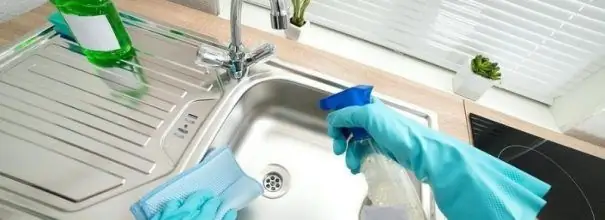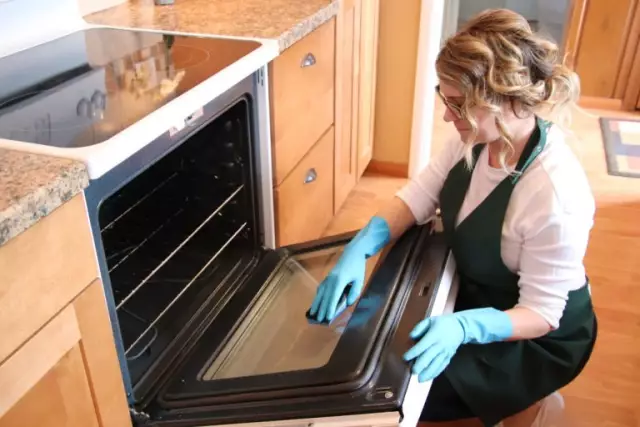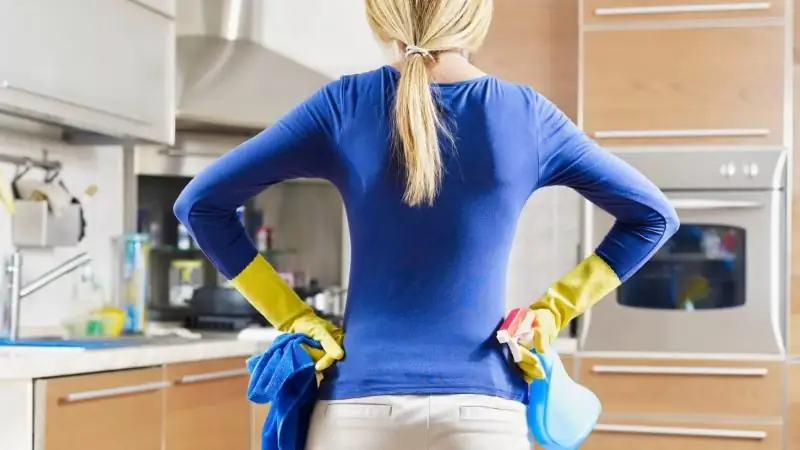
Table of contents:
- Author Bailey Albertson [email protected].
- Public 2023-12-17 12:53.
- Last modified 2025-01-23 12:41.
10 dirtiest places in your home to start cleaning

Household dirt accumulates on all household surfaces: dust, debris, food stains and, of course, traces of a person's presence (hair, epithelial particles, etc.). All this provides food for the reproduction of harmful bacteria. It is worth identifying the places in the house most susceptible to pollution, from which you need to start cleaning.
Kitchen sink
The kitchen sink needs daily maintenance so that it does not create a breeding ground for pathogenic microbes. But we must remember that modern stone and porcelain stoneware surfaces are “afraid” of products containing acid.
Therefore, before using the purchased spray, carefully read the instructions for use. Chlorine-containing preparations are suitable for absolutely any kitchen equipment, which must be used regularly. They not only disinfect but also refresh the color.
The siphon under the sink accumulates food and grease residues, which can cause:
- Blockages. Debris reduces the pipe clearance and prevents water from entering the sewer system.
- Unpleasant smell. Bacteria, actively multiplying in a nutrient "broth" from organic matter, produce a lot of gas. It comes out through the drain and spoils the air in the kitchen.
To avoid such troubles, during general cleaning, you need to remove and disassemble the siphon, shake out the foul-smelling liquid from it into a waterproof bag, rinse all the parts in warm water with washing powder, and then reassemble the structure.
Computer keyboard
Crumbs, hair, dust - all this remains in the bowels of the keyboard. In addition, traces of sebum and microscopic droplets of saliva can always be found on the keys. The pathogenic microflora feeds on all of this, and bacterial colonies grow exponentially.
To prevent the keyboard from becoming a "biological weapon", it is necessary to regularly wipe it with wet wipes (preferably with a disinfecting effect), and from time to time blow it with a stream of air from a vacuum cleaner or a special balloon.
Kitchen towel
During cooking, a lot of grease and soot settles on the towels. But a much greater danger to health is posed by microbes that migrate to kitchen textiles from poorly washed hands.
Therefore, towels, potholders, linen napkins should often be sent to the wash (if there is a baby in the house, then every day), and then iron them with an iron.
Shower curtain
Even a visually clean curtain in the bathroom or shower is a breeding ground for infection. Together with water, particles of dead skin, soap and, of course, bacteria that live on the human body get on it.
Heat, high humidity and the presence of organic debris are ideal conditions for microflora reproduction. If one of the family members suffers from infectious diseases, then others can also become infected by simply touching the curtain and touching the mucous membrane.
This will not happen if you treat the curtain with disinfectants at least twice a week, and you must wash it once a month.
Doorhandle
We open and close doors many times every day, and our fingers are not always perfectly clean. Fat and dirt, invisible to the eye, accumulate on the surface. Therefore, the handles must be rinsed every time you clean.
For this purpose, regular liquid soap or an all-purpose detergent will work. If there is a person in the house with the flu or other contagious disease, it does not hurt to periodically spray the door handles with chlorhexidine or wipe it with 3% hydrogen peroxide solution.
Cutting board
Kitchen boards are a paradise for pathogenic flora. Especially dangerous are those on which they cut:
- raw fish and seafood;
- meat with blood and lard;
- poorly washed greens.
It is better not to use wooden boards for such purposes, as they are difficult to sterilize. And plastic - you need to thoroughly wash after each cooking with a composition containing chlorine.
Washer
Dirt remains inside the washing machine, and black mold can be seen on the rubber bands and around the drum. Both will stain your laundry, giving things a musty smell.
To combat such unsanitary conditions, special substances are needed - ordinary washing powder will be ineffective. First, you will have to manually, using a sponge and baking soda, wash the rubber cuff, and then place any cleaner with an antibacterial effect in the drum, and start the washing cycle indicated in the instructions on the package.
Toothbrush
The toothbrush is usually located near the sink in the bathroom, next to the toilet. When a person flushes the water, imperceptible spray scatters within a radius of three meters and falls on all surrounding objects.
In this way, the brush becomes infected with fecal bacteria, which migrate into the mouth during brushing and can cause intestinal upset. Each time before use, you need to wash the brush with soap, and during cleaning, also treat it with a disinfectant. The glass-stand should also undergo a similar procedure.
Dustbin lid
If the bucket is opened manually, rather than using a pedal, germs accumulate on the lid. Therefore, it must be periodically wiped with antibacterial wipes, and once a month rinsed with running water, having previously soaped.
Disinfectant solutions such as bleach are also suitable for cleaning the lid and cleaning the main container.
Dish sponge
In the porous structure of the sponge, food residues and fat get stuck. It is completely impossible to rinse them out, so the dishwashing tool turns into an incubator for germs and viruses.
Microorganisms get there from dirty dishes and cutlery, and then spread throughout the dishes. This is one of the common ways of transmission of infection. Therefore, replace the old sponge with a new one every 2-3 days.
Sterilization in the microwave or soaking in a vinegar solution does not make sense, since in this way it is possible to destroy only the flora that does not pose a danger to humans.
Recommended:
How To Get Rid Of Spiders In A Private House, Apartment, Balcony, Windows And Other Places Forever, Tips With Photos And Videos

How to get rid of spiders in a house or apartment. Should you be afraid of them? How to remove spiders: effective chemicals and folk remedies
Fly Lady System: Basic Principles Of House Cleaning, Where To Start, How To Fill Out An Audit Trail And Other Recommendations + Reviews, Photos And Videos

Fly Lady house cleaning system: principles, pros and cons, who is it for? Reviews
How To Clean A Stove With Your Own Hands - Repair, Cleaning A Brick Russian, Bath, Round Stove From Soot Without Disassembling Why It Does Not Heat Well, Reasons, Cleaning Wells, G

How to repair and clean the oven with your own hands. Types of repair, when and why you need it. List of necessary tools and nuances to consider
General Cleaning Of The House: Where To Start And How To Quickly Do It + Photos And Videos

Where to start general cleaning of the house. The secrets of perfect order in the kitchen and bathroom. How to clean an apartment after renovation. The original way of cleaning Marie Kondo
Tips For Those Who Decided To Redevelop An Apartment: How To Legalize Redevelopment, Where To Start, Possible Options, As Well As Photos And Videos

Practical advice and recommendations for redevelopment of one-room and two-room apartments. Redevelopment legalization. Permitted and prohibited works
